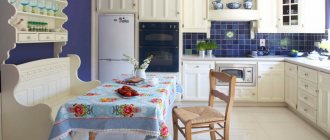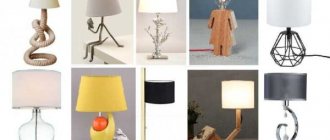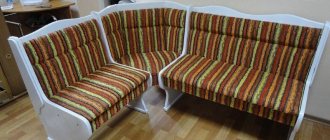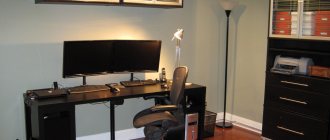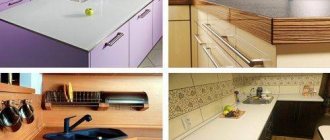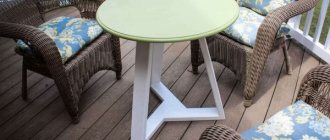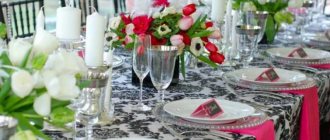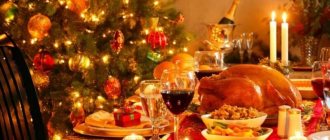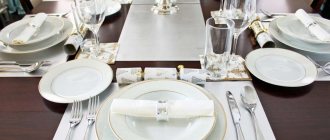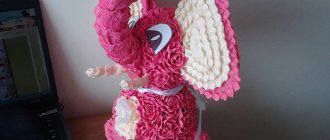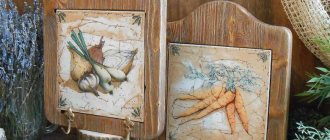Any kitchen requires a dining table. What it will be like depends on the design of the dining room itself. A properly selected tablecloth for the kitchen table will help to add comfort and make the place where the whole family gathers cozy.
To refresh a boring kitchen interior, sometimes it’s enough to lay a new tablecloth on the table
How to choose a tablecloth design
Deciding on a model is sometimes not easy. Many factors influence the color, shape, fabric and its size. These features need to be taken into account before choosing a tablecloth for your kitchen interior.
The tablecloth decorates the table, muffles the sound of appliances and protects the tabletop from dirt
Important! Don't make style mistakes.
A classic kitchen requires calm colors, restrained shapes and natural fabrics. Modern design prefers minimalism and discreet colors. The Venetian style, on the contrary, is replete with shades, rich in stitches and lace.
For a classic kitchen, it is better to choose a tablecloth made of linen or cotton.
Towels, curtains, rugs and rags in the Provence kitchen, echoing, make it come alive. This variety of details will be complemented by a tablecloth made in the same style.
Tablecloth with floral print in the interior of a Provence style kitchen
We can distinguish the main categories of modern types of tablecloths:
- Decorative, most often used as “table decoration”, serve as an interior item.
- Dinner (everyday and formal), diverse linens give the table a complete composition and protect the surface from various types of damage.
For everyday use, choose tablecloths made from inexpensive and practical fabrics
The latter, in turn, can be single-layer, or correspond to a classic table setting, representing a muleton (a covering that is laid under the tablecloth) and a naperon (the main fabric). Two-layer fabrics originate from the restaurant chain, but have long taken root in home use.
Festive tablecloths can be simply elegant or themed, there can be several of them in different styles
There is a widespread tendency to decorate the table with table runners of different configurations, materials and colors.
Tablecloth runners are laid directly on the table surface or on top of the main tablecloth
I wonder how tablecloths for the kitchen are selected?
Tablecloths and napkins
Napkins are used for serving along with tablecloths. They can be:
- paper;
- fabric;
- non-woven.
By size they are divided into table and tea rooms, that is, 46 by 46 cm and 35 by 35 cm. You need to select napkins to match the main fabric. The products are available in table sets, but they can easily be sewn or knitted.
Napkins are used for serving along with tablecloths.
Decorate the table with napkins:
- for everyday life, square or rectangular paper napkins are suitable, on which cutlery is laid out;
- It is unacceptable to use paper napkins at a celebration. At each personal place we lay out fabric products in folded or rolled form. A festive option - napkins made of expensive fabric, tucked into porcelain or silver rings, complemented by flower boutonnieres and artificial pearls;
- Practical non-woven napkins are suitable for children's parties and home feasts. They will add bright notes and complement the holiday atmosphere;
- For get-togethers with friends, small under-plate napkins that harmonize with the color of the main cloth are suitable. Although you can lay them out directly on a wooden or glass tabletop. The plate with cutlery should fit on a napkin.
On a glass table
Glass tables are installed in small kitchens. Furniture visually expands the space and seems weightless. The disadvantage is the unpleasant clanking of cutlery on the tabletop, so I want to cover it with a soft cloth . But the panel will hide the beauty of the glass; it is better to use stands for plates and a runner. A runner is a narrow strip of fabric in the center or diagonally of the table. Using fabric, we cover the areas of the glass tabletop that are more often exposed.
The lower shelf is often located in the underframe. We arrange low vases with flowers, compositions made of shells, lay out a rug or a piece of bright fabric.
For a wedding
Wedding tablecloths are used to decorate banquet tables, a table with boutonnieres and gifts. The shape of the panels follows the shape of the table top, that is, they are round, square or oval.
With bright elements
Attributes needed for wedding celebrations:
- Naperons are the same tablecloth, only they are placed on top of the main cloth. It is faster to replace it with another one if dirt gets in or liquid spills than to change the long bottom panel. A set of two panels muffles the sound of cutlery.
- Banquet or buffet skirts are used to decorate the canvas falling from the tabletop.
- Muleton - laid as a backing under the main panel to prevent slipping.
- Runners, runners or paths - we set the table on top of the tablecloth, although you can do without it. The main canvas made of coarse material with a tulle track looks interesting. It is allowed to simultaneously use paths of different colors intertwined on the tabletop.
For wedding tablecloths, linen or cotton fabric with the addition of synthetics is suitable. Silk panels are used less frequently and the price is higher.
Napkins and napkins should be sewn from fabric of the same texture as the main fabric, and synthetics are suitable for buffet skirts.
For the New Year's table
Wedding style
We decorate the table in a color scheme that matches the style of the celebration:
- Classic style - strict satin panels with the same tracks. There should be no lace, ruffles or flounces on the canvas. We choose fabrics of white, milky or cream shade. The color of the napkins should match the tone that prevails in the decoration of the room. They highlight the light palette with vases of flowers - roses and peonies.
- Provence - the airiness of the style is expressed by tablecloths of lilac, lavender, light blue, yellow, and steel colors. We complement it with ribbons, embroidery and lace. We place decor on the tables - figurines of angels, cages with pine branches and flowers.
- Shabby chic - for a wedding in a floral style. We choose natural fabrics with floral motifs. The predominant palette is white and light pink. We set the tabletop with a long white tablecloth with large roses, complemented with lace runners, bows, and lace.
- Vintage - suitable for celebrations in nature. An abundance of bright details, flower bouquets, antique sets and figurines. Large flowers must be painted on the services. Tablecloths are made from expensive materials and decorated with flounces, rhinestones and beads. Instead of a white cloth, choose coral, pink or scarlet.
- Marine style involves a combination of two colors - white and blue. The decoration of the hall in light colors is combined with white covers on chairs and napkins. We cover the tabletops with long blue panels, and place paths with white and blue stripes in the center.
Banquet option
With a white tablecloth
White tablecloths will decorate any feast, although stains quickly appear on the fabric, it needs to be washed and bleached more often. As an option, use fabrics made from unbleached linen, laying white tracks on top of the colored cloth.
White lace panels made from natural fabrics look festive. Beautiful material wears out, absorbs liquid and does not smooth out well. If you choose a fabric with synthetic fibers for your feast, it will make cleaning easier. Such products are easily washed from stains, dry quickly, and do not wrinkle.
With a red tablecloth
A rich red tablecloth is suitable for New Year's feasts. But there shouldn’t be too much red, so as not to turn the room into a blazing spot.
White tablecloths will decorate any feast
Design tips:
- We choose a panel of any red shade - from scarlet to rich ruby tone. We spread a narrow white or red-white path in the center, which will divide the table into zones and reduce the brightness of the composition.
- We spread a red lace tablecloth on top of a long white cloth; napkins are made of red fabric with white lace.
- To match the red fabric, you can sew chair covers from the same fabric, but there is an interesting idea - we add white covers and tie them with red satin ribbons.
- We spread a long white and red fabric on the base, and decorate the top with a short thick cherry-colored tablecloth.
With a turquoise tablecloth
Turquoise shades are suitable not only for everyday life, but also for decorating themed parties. Turquoise evokes coolness, gives a feeling of calm, and encourages conversation:
For a romantic dinner
- Setting the table for a boy's birthday. We focus on the marine theme - tablecloths and napkins in turquoise color, complemented by garlands of flags and balls of the same shade. A fishing net, shells and pebbles in glass vases will complete the composition.
- For a romantic dinner, combine turquoise with gold. We set the tabletop with an expensive cloth with a complex gold pattern on a turquoise background, and wrap the napkins with a string of turquoise beads.
- We decorate a table in country style for gatherings with friends. We combine chocolate brown shades with turquoise. We place turquoise dishes on a wooden tabletop and use wicker coasters for plates.
The combination of turquoise with orange tones promotes appetite. In the summer, we complement the table setting with decorative pumpkins or vases with orange flowers; in winter, we place wicker baskets with oranges.
Suitable for minimalist interiors
A tablecloth for everyday life and holidays can be sewn from light-colored natural fabric. The canvas will highlight any set - white or with a large floral pattern. If you want to have the product in the same palette as the dishes, then sew a matching satin ribbon around the perimeter. For a coffee table, finishing the panel with discreet lace is suitable. We update the old tablecloth by laying transparent fabric or tulle on top.
VIDEO: Updating the interior with accessories
Tablecloth on the table
How to choose the right one?
We decide on the purpose of the tablecloth; should it be water-repellent?
When making her choice, every housewife should understand what function this or that model performs. It is advisable to have several canvases of different quality available.
There may be unpleasant incidents at the table, spilled drinks, greasy drops, overturned sauce, and the tablecloth should always look neat. In this case, it is worth considering the option of waterproof or waterproof fabric with impregnation. One that is easy to maintain and, in addition, will protect the table surface from damage.
Tablecloth with water-repellent surface suitable for everyday use
Most often, water-repellent tablecloths are made from artificial materials:
- synthetic;
- semi-synthetic (natural fiber alternates with artificial).
Oilcloth tablecloths make up a separate category of table decoration. This material is not afraid of “neither rain nor slush,” but its strength and environmental friendliness leave much to be desired. It is worth noting that today this category of goods is presented in assortment.
Still, from the point of view of aesthetics, to perfectly match the kitchen, it is advisable to abandon the film on the table. There are a lot of modern tablecloths for the kitchen table.
Openwork tablecloth options
In ancient times, tablecloths were crocheted, which made it possible to create exquisite options designed to decorate the festive table. At the moment, handmade items are also quite popular.
Handmade openwork tablecloth
If you are familiar with crocheting skills, then it makes sense to create a masterpiece yourself. There are several options:
- A tablecloth consisting of a large number of motifs (in the form of circles, squares or triangles), which are then sewn together.
Openwork tablecloth from a large number of motifs
- A tablecloth knitted in a single fabric.
Knitted tablecloth on the table
Such solutions will highlight individuality, because even the same master will not be able to create two completely identical products. If you can be patient, the reward will be a luxurious option that allows you to organize a luxurious feast.
How to choose a tablecloth to match the shape of the table (oval, round)
Depending on the table configuration, you need to choose a tablecloth. For example, for an oval piece with an expensive tabletop, an oval water-repellent tablecloth for the kitchen table is suitable.
In most cases, the shape of the table and tablecloth should match
For a round table – a tablecloth with an elastic band. But there are some rules:
- A tablecloth, either round or square, laid diagonally, is suitable for a round kitchen table;
- An oval tablecloth for the kitchen, as well as a rectangular one, with evenly falling edges, is suitable for an oval table;
- It is advisable to lay tablecloths of appropriate shape on square and rectangular tables.
A square tablecloth on a rectangular table is a rather bold decision
Finding the optimal size. For a harmonious perception of dishes and the appearance of the table, it is customary for the edges of the tablecloth to fall by about 20-25 cm. This means that the length and width of the cloth should exceed the dimensions of the tabletop by no more than 30 cm, but not less than 15 cm. Otherwise, the tablecloth will be too short.
A floor-length tablecloth is only suitable for banquet tables, and a very short one looks bad
The exception is linen material. It shrinks a lot when washed. Therefore, when buying this product, you need to worry about additional centimeters in advance.
You shouldn’t cover the table with floor-length fabrics, much less combine them with chair covers, the whole look of the dining room is lost, and the feeling of a cafe or restaurant appears. In addition, floor length is unsafe if you have small children.
Using a tablecloth you can hide some of the imperfections of the table top and legs and give a solid look to an inexpensive table
Standard tablecloth sizes
It should hang equally from all sides of the table; the length of the hanging part of the product is calculated as the difference between the dimensions of the table and the fabric, which must be divided by two.
The length of the fabric cut depends on the length of the table; to it you need to add double the size of the overhang from the table. These calculations can be used for non-standard tables; for them, it is better to sew the tablecloth yourself or use the services of an experienced seamstress, and before doing this, accurately measure the dimensions of the furniture.
For ease of selection, we present the standard sizes of tablecloths, which contain 50% polyester and their shrinkage is no more than 2%. In all of the above cases, the width of the tablecloth is assumed to be 160 cm.
| Table dimensions, mm | Tablecloth size, mm |
| 800×1600 | 1224×2040 |
| 800×1400 | 1224×1836 |
| 800×1200 | 1224×1632 |
| 800×800 | 1224×1225 |
| 700×1100 | 1122×1530 |
| 700×700 | 1122×1122 |
| 600×600 | 1020×1020 |
Choosing the color of the tablecloth
There is a place to roam around, to use your imagination and art skills. There are a huge number of offers on the textile market. The tips here are:
- Almost any table setting will suit light, white shades. This tablecloth is ideal for both a holiday and a regular dinner; it is universal. White with lace is an elegant option for lavish celebrations. White linen, silk, jacquard are delightful table frames.
- Blue goes well with fish and seafood menus. The cool shade soothes, promotes relaxation and relaxation.
- Green is the personification of nature, perfect for kitchens in the country, in a country house, or to match the style of an apartment.
- Red and similar passionate shades are ideal for a romantic dinner or a memorable event.
- Bright colors are used for buffet tables, children's parties, and themed parties.
- A tablecloth with prints will highlight a certain mood and is quite suitable for tea drinking.
The tablecloth is ideal as a bright accent in the kitchen interior
A tablecloth of any shape can be complemented with napkins and other textile elements
Depending on the celebration, tablecloths are complemented with a set of napkins of the same theme.
Selecting the material
Linen (natural ecological material). Linen tablecloths perfectly complement any kitchen, have a dense texture and are relatively resistant to stains, flow well, emphasize the presentation of the dishes on the table, and have increased durability.
Linen fabric looks very expensive and elegant
Cotton is not inferior to flax from a health and environmental point of view. Easy-to-care material (satin, calico) is soft to the touch, gives comfort to everyone gathered at the table, the best in the price-quality category.
Modern cotton tablecloths can be impregnated with Teflon or acrylic for water resistance
Luxurious silk, most often used for decorative stories. Rich and eye-catching silk models will decorate any tabletop and add shine and chic.
Silk tablecloths are the most expensive and require careful handling
Polyester and viscose, economical materials. Excellent color retention and suitable for everyday use. Polyester models are valued for their water-repellent properties.
Synthetic fabrics withstand a large number of washes, do not wrinkle and generally make the housewife’s work easier.
In an effort to create a warm atmosphere in the home, it is important to consider not only the choice of dishes, but also the appropriate table setting. The right tablecloth will become the main accent, harmoniously highlighting the tastes of the owners, the style of the kitchen, and will give the mood to all guests.
